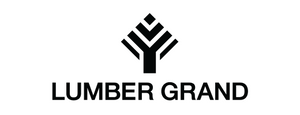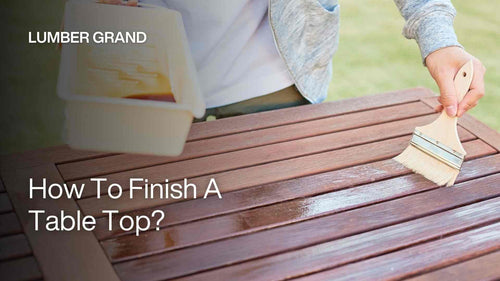You are preparing to make a river epoxy table with a length of 10 inches? At this time, a question will appear in your mind: "How much epoxy do I need for a river table?" If you have enough key parameters about the length, width and height of the table, there is a tool called the deep pour epoxy coverage calculator that will help you calculate the amount of epoxy. However, there is still another way to calculate manually, because the calculator may not be 100% accurate. And more, if you do not have a support tool, you can still use enough epoxy to pour a resin table. Find out now with Lumber Grand!
How Much Epoxy Do I Need for a River Table?
To answer the question: "How much epoxy do I need for a river table?", you will need to consider 3 key factors: the table dimensions, the wood type, and the pouring depth.
To get an approximate epoxy volume, you can use this simple formula to know how to calculate how much epoxy for river table:
Epoxy Volume = (Length × Width × Depth) - (Wood Area).
For example, if you’re making a 48” x 24” table top with a 2” wide river and a 1.5” pour depth:
-
Table Surface Area: 48” x 24” = 1152 in².
-
Estimated Wood Area (assuming 2 slabs, each 10” wide): 48” × 10” × 2 = 960 in².
-
Epoxy Area: 1152 - 960 = 192 in².
-
Epoxy Volume: 192 x 1.5 ≈ 1.24 gallons.
Note: These numbers vary depending on the wood's shape, voids and thickness.
 The exact amount of epoxy depends on the dimensions, the wood type and the pouring depth
The exact amount of epoxy depends on the dimensions, the wood type and the pouring depth
Photo: ©Mariusz Pietranek on Canva.com
3 Key Factors That Affect Epoxy Volume Calculation
Is the calculator 100% accurate? It's good to have a tool to help, but it's only relatively accurate. Because there are external factors such as the type of wood and the style you design and the pouring technique, we don't think you should rely entirely on the tool to pour epoxy table tops.
If you use the overflow method to let the epoxy flow over the edges to make a river table, you will need more epoxy. You should add 5-10% epoxy volume to avoid loss that interrupts the pouring process. So how much epoxy do I need for a river table is enough? The factors we mention below will answer this question!
1. Table Dimensions
When discussing an epoxy coat, the standard thickness to make an epoxy river table ideal is 1/16 inch to 1/8 inch. But corresponding to that coverage, you need to determine the specific size of the table top. Larger tables require significantly more epoxy, especially if the river section is wide.
-
Small coffee table (36 x 18): 0.5 - 1 gallon.
-
Medium round dining table (29” diameter, 1.5” thick): 1.3 - 1.8 gallons.
-
Large conference table (96 x 40): 4 - 5.3 gallons.
 Different river table sizes and epoxy requirements
Different river table sizes and epoxy requirements
Photo: ©andriiafanasiev on Canva.com
2. Wood Type & Its Impact on Epoxy Usage
Wood choice matters more than you think when you are curious about how much epoxy do I need for a river table. Some woods absorb more epoxy, while others have large natural voids that need extra resin.
-
Highly Absorbent Woods (e.g., pine, oak, cedar): Requires a sealing coat before pouring.
-
Dense, Non-Porous Woods (e.g., walnut, maple, cherry): Uses less epoxy, minimal absorption.
-
Live Edge Slabs: Often have cracks, knots, and uneven edges that demand extra epoxy.
If your slabs have large voids, cracks, or bark pockets, you might need 30-50% more epoxy than the standard calculation.
 Close-up of live edge wood with natural voids
Close-up of live edge wood with natural voids
Photo: Lumber Grand
Shop now: Square Wood Epoxy Resin Table Top 15 Inches
3. Epoxy Pouring Depth
The depth of your epoxy pour is another crucial factor in determining how much epoxy do I need for a river table. A deeper pour means more epoxy.
-
Shallow Pours (1” deep): Requires less epoxy and is quicker to cure.
-
Standard Pours (1.5” deep): A balanced amount of epoxy with minimal shrinkage.
-
Deep Pours (2-3” deep): Requires much more epoxy and takes longer to cure. These deep pours may even require special epoxy designed for thick layers.
Is deep pour epoxy difficult? It should not be too difficult if you pour in thin layers, slowly spread the resin out and keep the temperature between 72 and 74°F. You should mix the resin and hardener properly in a 2:1 ratio. If you see bubbles during the deep pour, use a heat gun or blowtorch to remove them.
 Epoxy curing process in different pour depths
Epoxy curing process in different pour depths
Photo: WiseBond®
Cost Estimation: How Much Will the Epoxy Cost?
In the United States, epoxy resin will cost around $12 per square foot and about $80 per gallon. A river table’s cost will vary based on how detailed you design it, including live edges, different wood types or custom epoxy colors. If you make an epoxy table for a dining room you can spend $400-$1200.
Larger tables require additional materials, such as epoxy resin and wood. Refer to the example below.
-
Small River Table (3 ft x 2 ft): You’ll likely need 1-2 gallons of epoxy, ranging from $80 to $300.
-
Medium to Large Tables (4 ft x 3 ft or more): Expect to use 3-4 gallons, which will cost you anywhere from $180 to $600.
Factors affecting epoxy costs when you need to make an epoxy river table:
-
Epoxy resins for river tables or epoxy waterfall tables possess a thicker form and more strength - they generally have a greater cost.
-
If you add pigments or glitter to your epoxy, the costs will be higher but the result will also be unique.
-
If you're planning to buy epoxy tables, they are quite heavy. That’s why delivery expenses can differ, especially when someone orders from certain sellers.
Pro Tip: You can buy in bulk if you’re tackling a larger project! It’s one of the best ways to save 10-20%.
Pro Tips for Efficient Epoxy Usage
After answering your question about how much epoxy do I need for a river table, Lumber Grand gives you tips to minimize waste and save on costs when you use epoxy resin.
-
Measure and mix precisely: Usually 1:1 or 1:2 unless the manufacturer tells you otherwise. If you mix too much resin or hardener, it can result in waste or improper hardening.
-
Pour in layers: As we mentioned above, you should pour epoxy in thin layers so that it can dry, which will reduce excess and help you out to adjust the amount poured. To make the epoxy coat even, you need to use a specialized ruler like a flat, rigid scraper and use a stick to spread the epoxy layer evenly on the surface.
-
Control your environment: You should work in a room with a controlled climate, where the temperature is between 65°F and 75°F (18°C - 24°C) and the moisture level is low. Great moisture can make the epoxy need longer to dry and it can leave the finish looking poor.
-
Seal the edges: Before pouring the epoxy you put a narrow layer on the edges of the wood to keep air from leaving. It will keep the edges from taking in excess resin in getting the best finish for the epoxy river table.
-
Use the right tools: You may use a heat tool, to eliminate air bubbles, a scraper to level the resin and gear for safety, such as eyewear besides hand covers.
 Tips to help epoxy coating last longer on wooden table tops
Tips to help epoxy coating last longer on wooden table tops
Photo: ©Thaicha on Canva.com
For more information about us, you can visit Lumber Grand's blog and discover how to build an epoxy table top.
This article answers "How much epoxy do I need for a river table?", which is essential to avoid running out or overspending. One more information for you the time to make an epoxy river table can range from 3 - 10 days, however it can also last from 2 - 3 weeks depending on the style and the number of layers of epoxy you pour. To calculate epoxy volume exactly you need to consider the table size and wood type. Happy crafting!

















































